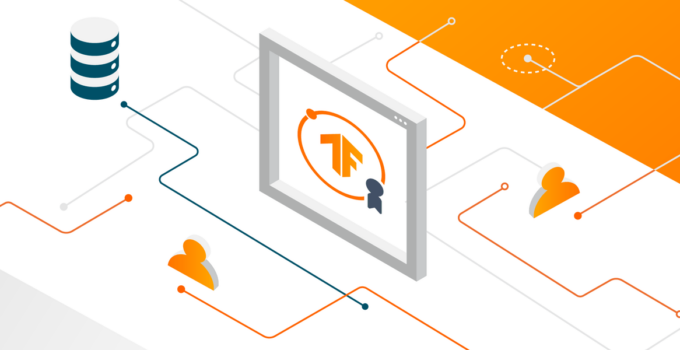TensorFlow is a free and open-source software library used for research and production in Machine Learning (ML). It is based on a branch of Artificial Intelligence (AI) called deep learning, which derives inspiration from the way that human brain cells communicate with each other. With deep learning playing a pivotal role in ML initiatives by today’s tech giants, TensorFlow has become hugely popular in ML circles.
A bit of the origin of TensorFlow: Developed by the Google Brain team for internal Google use, it was released for external use in 2015 and continues to be used for deep learning or machine learning problems such as classification, perception, understanding, discovering, prediction and creation. Today, it is among the most popular tools and frameworks for ML, having won over ML engineers and developers across industries.
Shared below are the main reasons behind TensorFlow’s popularity.
1. TensorFlow is the most widely available AI platform

Source: anyline.com
TensorFlow is the only framework available for running ML models from the cloud to the tiniest microcontroller device. Be it x86, ARM64, NVIDIA GPU, or Google TPU, the models trained with TensorFlow can support many different architectures. TensorFlow Lite, the toolset for mobile, embedded, and IoT devices, helps developers prepare the model once and deploy it to an Android phone, Raspberry Pi, Jetson Nano, EdgeTPU, or even an ESP32 microcontroller. Moreover, one doesn’t need to make any changes to the code for any modern browser to run the TensorFlow model.
2. TensorFlow 2.0 is even more powerful
TensorFlow 2.0 toolkit capitalizes on the Keras framework, especially its simplicity and intuitive approach. This compatibility of TensorFlow and Keras has worked out well for developers working on complex deep learning models. Undoubtedly, its performance is high and matches the best in the industry, and its unique approach allows easy monitoring of the training progress of models and tracking several metrics.
Below are a few key features that translate into significant advantages for developers using TensorFlow:
a) Good graph visualizations: TensorFlow has high-quality computational graphs built-in and is much better than those in libraries such as Torch and Theano.
b) Library management: With Google’s backing, it offers seamless performance, quick updates, and frequent new releases with new features.
c) Debugging: With TensorFlow, developers can execute subparts of a graph to introduce and retrieve discrete data
d) Pipelining: TensorFlow is designed to use various backend software (GPUs, ASIC).
e) Easy sharing of models: In many frameworks, sharing the model needs to provide its complete code. With TensorFlow, however, one can share just a checkpoint file and the knowledge of layers names one needs for inference.
f) Easy implementation: TensorFlow models allow for implementing the same model (without rewriting or recompiling it) in several projects regardless of their written language.
g) High flexibility: With a highly modular architecture, TensorFlow allows developers to use parts individually or use all the parts together. Such flexibility, in turn, makes possible non-automatic migration to new models/versions and A/B testing experimental ones.
h) Auto Differentiation: TensorFlow comes with automatic differentiation capabilities, boosting gradient-based machine learning algorithms. Once one has defined the computational architecture of a predictive model, combined it with one’s objective function, and added data to it, TensorFlow automatically manages derivatives computing processes.
i) Full use of one’s hardware: With its advanced support for threads, asynchronous computation, and queues, TensorFlow allows one to make the most of one’s available hardware. All one needs to do is assign the compute elements of one’s TensorFlow graph to different devices and manage the copies on its own. It also provides one with language options to execute one’s computational graph. Also deserving mention is the TensorFlow iPython notebook, which helps keep codes, notes, and visualization.
3. TensorFlow is part of public cloud platforms

Source: freepik.com
Today, a crucial part of public cloud platforms is the APIs for computer vision, natural language processing, personalization, and recommendation services powered by TensorFlow. All the big Platform as a Service (PaaS) players today – especially those with any ML presence, think Google AI Platform, IBM Watson Machine Learning, Azure ML, and Amazon SageMaker – have good integration with TensorFlow. Its supported platforms include Linux, macOS, Windows, and Android.
4. TensorFlow enjoys strong support in terms of tooling and integration
TensorFlow’s integration with Python IDEs has boosted its popularity among developers in a big way. Tools such as TensorBoard offer insights into the training process, and this, in turn, helps shape the ML model. Moreover, TensorFlow is designed to support multiple client languages. In addition to Python, it officially supports C++, JavaScript, Go, Java and Swift, although the only Python supports all available features.
5. TensorFlow has research and development backing from Google

Source: unsplash.com
Google has invested millions of dollars in research and development to enhance its ML powers with TensorFlow. Many of its products and services – including Google Assistant, Nest, Android – use TensorFlow. TensorFlow models can be run without a traditional computer platform in the Google Cloud Machine Learning Engine.
6. Community Support
Thanks to its high popularity, the TensorFlow community has built bindings to use the framework in other languages, such as C# and Ruby. This lends TensorFlow portability and lets developers use machine learning models for desktop, mobile, and even web applications.
Indeed, TensorFlow has played a crucial role in the growth and adoption of ML and AI. Not surprisingly, a May 2025 report dating to Hacker News Hiring Trends states that TensorFlow jobs are in great demand.
Today, there are many online resources one can explore to learn TensorFlow. But knowing it is not too easy either; it is essential to have a stronghold over the fundamental basics (especially Python) to begin with. Today, there are also many paid online classes that teach TensorFlow as part of their curriculum, including to kids and teens. At YoungWonks, Level 5 is taught ML and AI – including TensorFlow- as part of the curriculum. They get to use TensorFlow to build projects and get a real-life understanding of how it works. This will, in turn, help them get a headstart in the competitive world of ML and AI.







